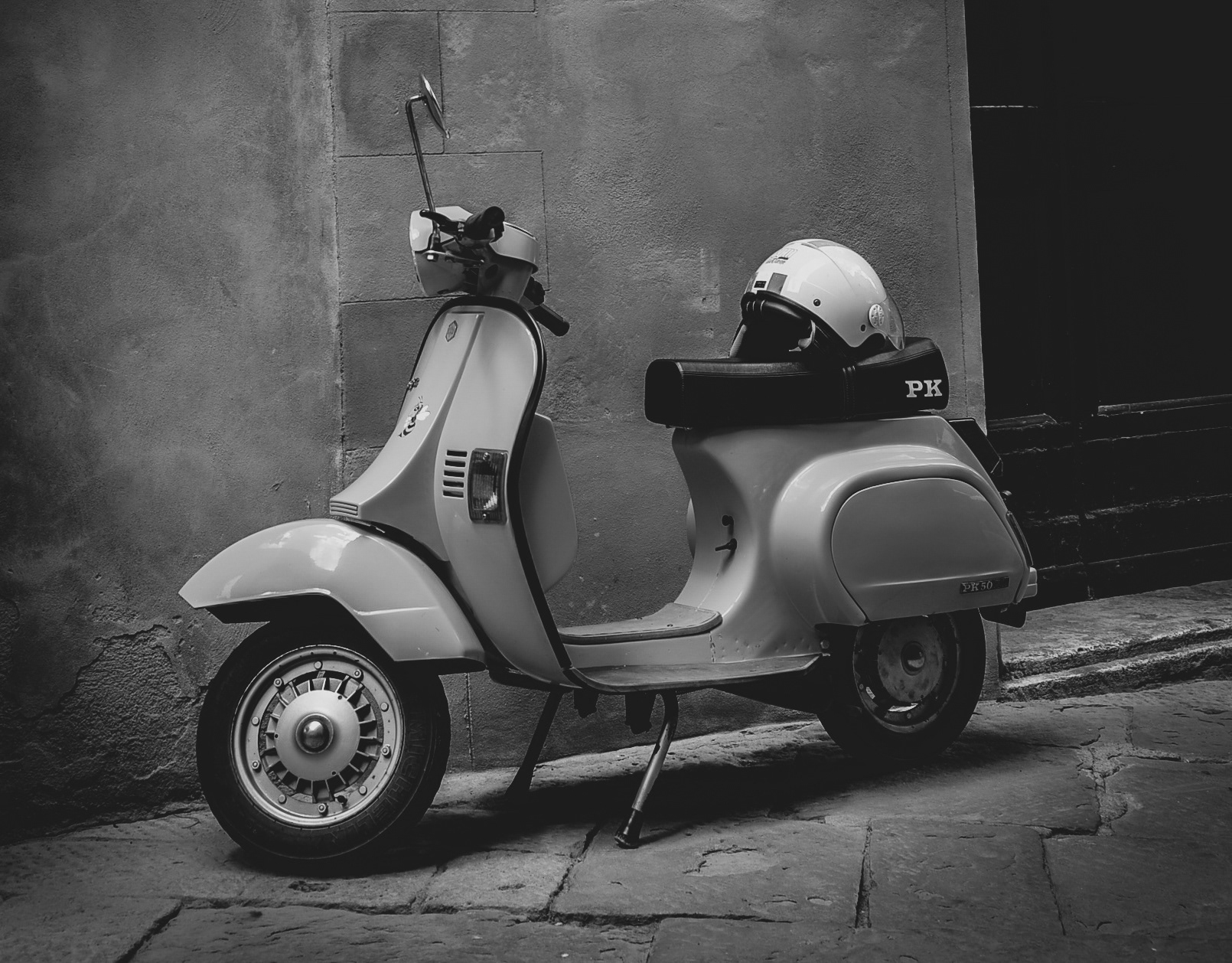Mediterranean Orange
Vincent van Gogh composed "Still Life with Basket and Six Oranges" in 1888 while he was in Arles-sur-tech, France. At this time he adopted a brighter palette and his paintings were saturated with yellow, ultramarine and mauve.
The still life epitomizes the natural vibrant light of the landscapes in the region. The sun-drenched fields and azure water of the Mediterranean are echoed in the background of the painting.
The Wasp
The first "500" was held at the Speedway in 1911 on Decoration Day, May 30, (as it was known from its inception in 1868 to 1967, when federal law made "Memorial Day" the official name), run to a 600-cubic-inch (9,800 cc) maximum engine size formula. It saw a field of 40 starters, with Harroun piloting a Marmon Model 32-based Wasp racer—outfitted with his invention, the rear-view mirror. Harroun (with relief from Cyrus Patschke) was declared the winner, although Ralph Mulford protested the official result. Eighty thousand spectators were in attendance, and an annual tradition had been established.
Many considered Harroun to be a hazard during the race, as he was the only driver in the race driving without a riding mechanic, who checked the oil pressure and let the driver know when traffic was coming. The Indianapolis Motor Speedway complex was built in 1909 as a gravel-and-tar track and hosted a smattering of small events, including ones for motorcycles. The first long-distance event, in "fearful conditions," was the 100-lap Prest-O-Lite Trophy in 1909, won by Bob Burman in a Buick.
These race spectacles had attracted 15,000 paying customers (and crowds of up to 40,000) persuaded principal owner Carl G. Fisher to spend $155,000 on repaving the track with 3.2 million bricks to make the gravel and tar track safer before the 1910 race; he also added a 33-inch (0.84 m) concrete wall around the track's circumference. They decided on 500 miles (800 km), the estimated distance a race car could run before dark descended on the track, and a spectacular purse of $25,000, equivalent to 82.93 pounds (37.62 kg) of pure gold. The combination allowed the track to rapidly acquire a privileged status for automobile races.
For musical entertainment before the start of the race, the Purdue All-American Marching Band has been the host band of the race since 1919. In 1946, American operatic tenor and car enthusiast James Melton started the tradition of singing "Back Home Again in Indiana" with the Purdue Band before the race when asked to do so on the spur of the moment by Speedway president Tony Hulman. This tradition has continued through the years, notably by actor and singer Jim Nabors from 1972 until 2014. Nabors announced in 2014, citing health-related reasons, that the 2014 Indy 500 would be the last at which he would sing the song.
The Borg-Warner Trophy is the trophy presented to the winner of the Indianapolis 500. It is named for and was commissioned by automotive supplier BorgWarner. It is permanently housed at the Indianapolis Motor Speedway Museum in Speedway, Indiana. Unveiled at a 1936 dinner hosted by then-Speedway owner Eddie Rickenbacker, the trophy was officially declared the annual prize for Indianapolis 500 victors.
Louis Meyer requested a glass of buttermilk after winning his second Indy 500 race in 1933. After winning his third title in 1936, he requested another glass but instead received a bottle. He was captured by a photographer in the act of swigging from the bottle while holding up three fingers to signify the third win. A local dairy company executive recognized the marketing opportunity in the image and, being unaware Meyer was drinking buttermilk, offered a bottle of milk to the winners of future races. Milk has been presented each year since then, apart from 1947 to 1955. Modern drivers are offered a choice of whole, 2%, and skim.
The garage area at the Indianapolis Motor Speedway is known as "Gasoline Alley." The nickname dates back to the early decades of the race, and for a time, referred specifically to one particular spot in the back where cars would refuel. Though the exact origin of the name is unclear, it may be loosely linked to the eponymous comic strip. Later, the nickname was used for the main corridor of the garage area, and eventually was used colloquially for the entire garage complex.
The infield of the track in the vicinity of turn one was known as the "Snake Pit." Long known for a reputation of rowdiness, heavy alcohol consumption, bikers, streaking, flashing, and an overall Woodstock/Mardi Gras atmosphere, the Snake Pit was a popular location for college-age and counterculture fans to spend time at the track, many of whom had little or no interest in the actual racing activities. The nickname "Snake Pit" was coined sometime in the early/mid-1960s, and appeared in print at least as early as 1968.
The area that eventually became the Snake Pit took shape very early on, prior to World War I. In the early decades of the Speedway, a railroad line connected Union Station in downtown Indianapolis out to the track and beyond. Many fans in the early years (and through 1963) arrived at the race by train. The Snake Pit eventually became more of a festive party zone. Later, the original turn one location was also razed to make room for road course modifications. In 2010, the turn three infield was officially named the Snake Pit, and began to be organized and officially marketed by management for concert events during the weekend race festivities.
Little Bambino
Balilla was the nickname of Giovanni Battista Perasso, a Genoese boy who started the revolt of 1746 against the Habsburg forces that occupied the city in the War of the Austrian Succession by throwing a stone at an Austrian official. The word Balilla is thought to mean little boy and is thus one of only two clues about Perasso's age (the other being an Austrian report that makes reference to "a little boy" throwing stones at officials).
Legend asserts that while some Austrian soldiers were dragging an artillery piece along a muddy road in the Portoria neighbourhood of Genoa, the piece got stuck in a moat. The soldiers forced onlookers and passers-by to dislodge it, cursing and lashing them. Disgusted by the scene, Perasso allegedly grabbed a stone from the road and skilfully threw it at the Austrian patrol, asking his fellow citizens in the Genoese dialect: "Che l'inse?" ("Am I to begin?" or "Shall I start?"), which set in motion an uproar which eventually caused the Austrian garrison to be evicted from the city. The phrase became proverbial in Italian as well.
For his supposed age and revolutionary activity, Perasso became a symbol of the struggle of the Italian people for independence and unification. Conversely, accounts of the sack of Genoa by Royal Piedmontese troops in 1849 mention soldiers running through the streets and shouting, "Genoese people are all Balilla, they do not deserve compassion, we must kill them all!"
Several types of the Fiat 508 car, produced during the 1930s, were also named for Balilla (Fiat 508 Balilla, Fiat 508S Balilla Coppa d'Oro, Fiat 508 Balilla Sport, Fiat 508 Balilla Spider Militare). His memory is also reported on the current (but composed in 1848) Italian National anthem, "Il Canto degli Italiani", popularly known as "Fratelli d'Italia" (Brothers of Italy): "I bimbi d'Italia / si chiaman Balilla / il suon d'ogni squilla / i Vespri suonò". The second reference is to the 1282 insurrection called the "Vespri Siciliani".
Launch Into The Deep
So it was, as the multitude pressed about Him to hear the word of God, that He stood by the Lake of Gennesaret, and saw two boats standing by the lake; but the fishermen had gone from them and were washing their nets. Then He got into one of the boats, which was Simon's, and asked him to put out a little from the land. And He sat down and taught the multitudes from the boat.
When He had stopped speaking, He said to Simon, "Launch out into the deep and let down your nets for a catch." But Simon answered and said to Him, "Master, we have toiled all night and caught nothing; nevertheless at Your word I will let down the net." And when they had done this, they caught a great number of fish, and their net was breaking. So they signaled to their partners in the other boat to come and help them. And they came and filled both the boats, so that they began to sink.
When Simon Peter saw it, he fell down at Jesus' knees, saying, "Depart from me, for I am a sinful man, O Lord!" For he and all who were with him were astonished at the catch of fish which they had taken; and so also were James and John, the sons of Zebedee, who were partners with Simon. And Jesus said to Simon, "Do not be afraid. From now on you will catch men." So when they had brought their boats to land, they forsook all and followed Him.
- Luke 5:1-11
Rosso Corsa
Rosso corsa is the red international motor racing colour of cars entered by teams from Italy. Since the 1920s Italian race cars of Alfa Romeo, Maserati, Lancia, and later Ferrari and Abarth have been painted in rosso corsa ("racing red").
Pink
Marilyn Monroe wore a shocking pink dress in the 1953 film Gentlemen Prefer Blondes, directed by Howard Hawks. The dress was created by costume designer William "Billy" Travilla and was used in one of the most famous scenes of the film, which subsequently became the subject of numerous imitations, significantly from Madonna in the music video for her 1985 song "Material Girl".
The pink dress was worn by Monroe in the role of Lorelei Lee in the famous sequence in which the actress sings the song "Diamonds Are a Girl's Best Friend", the choreography accompanied by several suitors in dinner clothes. Travilla's notes reveal that Monroe wore two identical copies in the scene as it took a long time to shoot and the dress, being floor length, was very prone to getting dirt on it.
The only pink dress known to survive was auctioned at Profiles in History on 11 June 2010, with an estimated price of between $150,000 and $250,000 and described as "the most important film costume to ever come to auction". The dress ultimately sold for $370,000.
Annette's Charm
Annette Joanne Funicello (October 22, 1942 – April 8, 2013) was an American actress and singer. Annette Joanne Funicello was born in Utica, New York, to Italian Americans Virginia Jeanne (née Albano) and Joseph Edward Funicello. Her family moved to Southern California when she was four years old.
When she was 16, Funicello got her first car from her father, a white 1957 Ford Thunderbird, which she would use as a daily driver for the next decade. The car was originally finished in Colonial White (EE) and was reportedly repainted in purple by George Barris under Funicello’s ownership. The car is then said to have been painted silver circa 1968 and given to Funicello’s younger brother as a birthday gift, who drove it until it was sold out of the family. No one knows for a fact when the celebrity provenance was lost, but when the current owner picked it up in 2003 and decided to restore it, he had no idea who it had belonged to when purchased.
1913 Delage
This spectacular car is none other than the 1913 French GP and 1914 Indy 500 winner - a 1913 Delage, type Y factory works racer. Louis Delage (1874-1947) left Renault to open his own company in 1905. Always passionate about racing, Delage hired a new engineer in 1910 - Arthur Michelat, a Angers graduate (France's Army Heavy Artillery School). Michelat is credited with designing the type Y racers of 1913. The cars (4 type Y racers are thought to have been built) are equipped with a 4-valves per cylinder, 4-cylinder engine producing roughly 130hp.
The 4th International 500-Mile Sweepstakes Race was held at the Indianapolis Motor Speedway on Saturday, May 30, 1914. The 1914 Indianapolis 500 was a star studded event with Duray moving over to drive for Peugeot (the other Peugeot being driven by Goux). Rene Thomas and Albert Guyot would drive for Delage and hometown favorites Oldfield, Wishart, and Rickenbacker would drive for Stutz, Mercer, and Duesenberg respectively. With W.F. Bradley as team manager yet again, the number 16 Delage driven by Thomas would win the event.
René Thomas (March 7, 1886 – September 23, 1975) was a French motor racing champion. Thomas was also a pioneer aviator. A leading driver in his native France, René Thomas traveled to the United States to compete in the Indianapolis 500 on four occasions. He won the 1914 Indianapolis 500 on his inaugural try driving a Delage.
On May 28, 1973, he returned to Indianapolis to drive his winning Delage in a series of parade laps, prior to the start of the 1973 Indianapolis 500. Although he did not drive the car himself, he did sit in the seat where the riding mechanic would sit. He died on September 23, 1975 in Paris, France at age 89.
Devil In The Details
1969 Ford Mustang Mach 1
Under the auspices of Ford President Semon "Bunkie" Knudson, high output is the primary focus of the Mustang lineup. The Mach 1, Boss 302 and Boss 429 are the performance-ready stablemates Knudson has in mind. With a larger presence, the latest breed of Mustang presents a requisite dose of Shelby-influenced aggressive styling. Larger grille, swooping roofline and non-functional side scoops borrow from earlier Shelby Mustangs. Dual headlamps were introduced in 1969, with the extra pair set into the outer area of the grille. The corralled grille pony was replaced with the pony and tribars logo, set off-center to the drivers side. The wheelbase remained 108 inches, but the overall length increased by almost 4 inches, and the width increased by almost half an inch.
Semon E. ("Bunkie") Knudsen (1912-1998) was the son of William S. Knudsen, a former president at General Motors. In 1968, at the age of 55, after a successful 29-year career at GM in which he rose to become head of the Pontiac Division, Bunkie left GM to take the position of President at Ford Motor Company. He was a little miffed that he had been recently passed over for the same position at GM, which was of course the exact same position his father had once held. Henry Ford II personally recruited Bunkie in January 1968, just days after GM's board had met and decided to offer the presidency to Edward N. Cole. A secret visit to Knudsen's mansion in Bingham Farms, Michigan near Detroit sealed the deal.
But Ford Motor Company had passed over a few talented insiders when it hired from outside the company. One in particular, 44-year old Lee A. Iacocca, who was the Executive Vice President, had proven himself a strong marketing guy. Iacocca was responsible for the Ford Mustang, one of Ford Motor Company's biggest successes, and was about to have another hit with the new Maverick. Iacocca was very disappointed and somewhat shocked when he learned that Knudsen had been hired, but those feelings turned into resentment when it was discovered that Knudsen planned to manage things from the plant instead of his executive office.
Knudsen sometimes arrived for work as early as 7:15 a.m., and would often tour the Ford Design Center, asking for changes to be made that would clash with the desires of the designers and the demands of other Ford executives. One of those executives was Iacocca, who felt that Knudsen was forcing policy changes in parts of the company that fell under Iacocca's responsibility. Apparently Chairman Ford was not thrilled with Knudsen's methods either, so in September of 1969, Bunkie Knudsen was fired from Ford.
Insiders at the time said Knudsen shouldn't have been surprised to have been fired, as he'd been warned earlier about moving too fast in his new job. That advice came from Henry Ford II. One insider reported that if Knudsen "had walked in quietly and made his way slowly for a year or two, there would have been no problem. But some people thought he was trying to take over. He just didn't understand the people at Ford. He was told six months after he got the job to take it easy, but he didn't. He should have learned to live with those people."
After his termination, when asked for his view of why he was fired, Knudsen said that Henry (Ford) "wanted to resume control of the company." Iacocca, when asked if he was sorry to see Knudsen go, replied: "I've never said 'No comment' to the press in my life, but I'll say it to that one."
Nifty Fifties
1955 Chevrolet Bel Air
Half way through the nifty fifties, the second generation Chevrolet Bel Air, appropriately dubbed the “hot one,” appeared with all new “motoramic” styling and an optional, new statement-making V8 power plant. Chevrolet enabled the everyday man the opportunity to own a virtually custom car without reaching too deep into their wallet, and Chevrolet savored the positive response.
William L. Mitchell (July 2, 1912 – September 12, 1988) is responsible for creating or influencing the design of over 72.5 million automobiles produced by GM, including such landmark vehicles as the 1938 Cadillac Sixty Special, the 1949 Cadillac Coupe deVille, the 1955-57 Chevrolet Bel Air, the 1959-1984 Cadillac DeVille, the 1963–65 and 1966-67 Buick Riviera, the 1961-76 Corvette Stingray, the 1970-81 Chevrolet Camaro, the 1976-79 Cadillac Seville, and the 1980-85 Cadillac Seville.
Mitchell spent the entirety of his 42-year career in automobile design at General Motors, eventually becoming Vice President of Design, a position he held for 19 years until his retirement in 1977. His design stewardship at General Motors became known as the 'Bill Mitchell era'.
Tired Of Giving In
I Dream a World
by Langston Hughes (1901-1967)
by Langston Hughes (1901-1967)
“I dream a world where man
No other man will scorn,
Where love will bless the earth
And peace its paths adorn
I dream a world where all
Will know sweet freedom's way,
Where greed no longer saps the soul
Nor avarice blights our day.
A world I dream where black or white,
Whatever race you be,
Will share the bounties of the earth
And every man is free,
Where wretchedness will hang its head
And joy, like a pearl,
Attends the needs of all mankind-
Of such I dream, my world!”
No other man will scorn,
Where love will bless the earth
And peace its paths adorn
I dream a world where all
Will know sweet freedom's way,
Where greed no longer saps the soul
Nor avarice blights our day.
A world I dream where black or white,
Whatever race you be,
Will share the bounties of the earth
And every man is free,
Where wretchedness will hang its head
And joy, like a pearl,
Attends the needs of all mankind-
Of such I dream, my world!”
Rosa Parks (1913-2005) occupies an iconic status in the civil rights movement after she refused to vacate a seat on a bus in favor of a white passenger in Montgomery, Alabama. In 1955, Parks rejected a bus driver's order to leave a row of four seats in the "colored" section once the white section had filled up and move to the back of the bus.
Her defiance sparked a successful boycott of buses in Montgomery a few days later. Residents refused to board the city's buses. Instead they carpooled, rode in Black-owned cabs, or walked, some as far as 20 miles. The boycott dealt a severe blow to the bus company's profits as dozens of public buses stood idle for months. The boycott was led by a newcomer to Montgomery named Martin Luther King, Jr.
In her autobiography, Rosa Parks: My Story (1992), Parks declares her defiance was an intentional act: "I was not tired physically, or no more tired than I usually was at the end of a working day. I was not old, although some people have an image of me as being old then. I was 42. No, the only tired I was, was tired of giving in."









